
CLPS 0500 Perception and Mind, John Marks Guest Lecture on “Music”
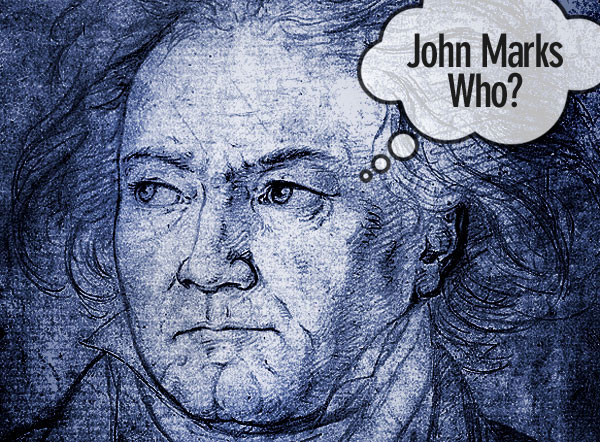 Courtesy Stereophile magazine.
Courtesy Stereophile magazine.
Preparation for Participation, Part One
A recent article (Mehr, et al., 2019) posits that across all cultures, song (meaning music with words) is a “cultural constant.”
To put it as simply as possible, “Everybody sings.” (Or, at least: Most people, in all cultures, sing.)
This, in and of itself, should not be surprising. People in most (if not all) cultures have since earliest times always heard birds singing (although admittedly, on a spectrum from the most simple to the most complex bird songs). If you do a web search with the query: “relationship between birdsong and human song” you will be presented with an engrossing salmagundi of results, with this one at the top (“Birdsong and Human Language”).
(Note, read that article in full only if it interests you; I just wanted you to be aware of the concept of a relationship between birdsong, and human song and language.)
What I found remarkable in the Mehr 2019 study is that study’s mention of a previous paper by the same team, reporting the experimental finding that:
[U]ntrained listeners in 60 countries could on average discern the human behavior associated with culturally unfamiliar musical forms. These behaviors included dancing, soothing a baby, seeking to heal illness, or expressing love to another person.
In other words, ordinary listeners could tell what kinds of songs they were listening to, even when those songs came from far-away places and radically different cultures. Continue Reading →
Rosen, Stevenson, and Delmoni: “Londonderry Air” (arr. Fritz Kreisler)
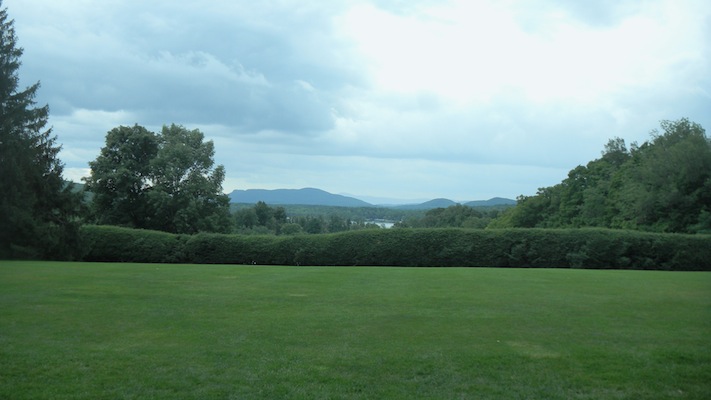 Photo by John Marks
Photo by John Marks
The above photo was not taken in Ireland, but it perhaps could pass; and in any event, it will have to do.
For St. Patrick’s Day, here are Nathaniel Rosen (cellist), Doris Stevenson (pianist), and Arturo Delmoni (guest violinist) playing Fritz Kreisler’s trio arrangement of “Londonderry Air,” also known as “Danny Boy.”
Rosen, Stevenson, and Delmoni: “Londonderry Air” (arr. Fritz Kreisler)
That track is from the 2-LP set Orientale, which was released on North Star Records in 1991. The project was my idea. I obsessively mother-henned the thing from soup to nuts, from concept to the sessions at Holy Trinity Church (David Hancock recorded), to the art-quality printing on the fabricated jackets, to the vellum paper for the signed numbered certificates. (Orientale on LP was a signed numbered limited edition of 2,000 2-LP sets.)
I find it gratifying that nearly 30 years later, Orientale 2-LP sets regularly sell between $300 and $500 on the used market. The top sale is $600 for a claimed sealed set. There is one set for sale now, at $549.99. The musicianship is otherworldly, captured in a David Hancock 30 ips two-track recording using Cambridge ribbon microphones. Doug Sax mastered it; he told me that the Tchaikovsky piece had made him want to “jump over the console.” I took that to mean that he liked it.
# # #
Kirill Petrenko, Berlin Philharmonic: Gustav Mahler, Symphony 6
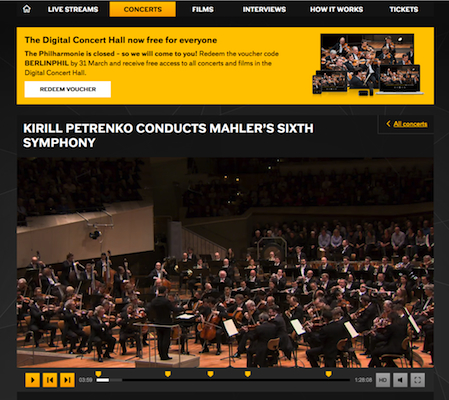
The Berlin Philharmonic has just made a really classy move: in view of the coronavirus pandemic, they have removed the paywall on their archived content. To put it another way, you can now binge-watch exceptional classical music performances for free.
While hunkering down under the electric blanket and waiting for the wine-store delivery person to arrive, one could do far worse in terms of internet browsing than to dive deeply into Gustav Mahler’s “Tragic” Sixth symphony. The orchestral playing is fabulous, and the sound quality is very very good. I was very pleased to see that Kirill Petrenko had opted for the authentic order of the inner movements; slow movement second, scherzo third. That performance was recorded January 25, 2020. More recommendations after the jump, as well as at least one comment. Continue Reading →
Joanne Polk: Louise Farrenc Etudes & Variations for Solo Piano
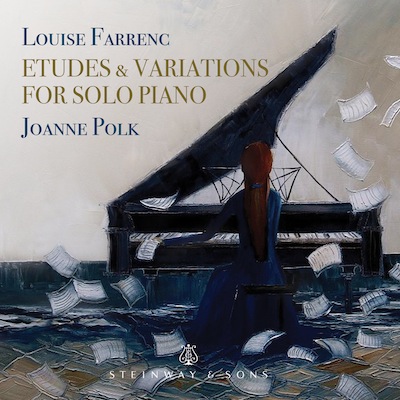
Joanne Polk: Louise Farrenc: Etudes & Variations for Solo Piano
Steinway & Sons CD (STNS 30133) and MP3 downloads available from Amazon
Hi-Res downloads (24-bit/96kHz stereo AIFF, ALAC, FLAC, and WAV) available from HDTracks
Streaming available from Tidal (and others)
Release date: February 7, 2020
Recorded May 15-17, 2019, at State University of New York Purchase College Performing Arts Center Recital Hall. Producer and recording engineer: Steven Epstein. Total time 70 min. 05 sec.
Here’s another winner of a recording from Steinway and Sons. As we have learned to expect, the recorded sound is superb.
Louise Farrenc (1804-1875), especially for someone who today merits not even the proverbial asterisk in most music guidebooks, had an amazing career. Judging from this release, Farrenc’s music is firmly in the mid-19th-century Romantic virtuoso-piano tradition of Liszt and Chopin, even to the extent of including crowd-pleasing paraphrases of (or, variations upon) opera themes or arias by Bellini (Norma) and Meyerbeer (Les Huguenots).
All of which pianist Joanne Polk presents with facility, fluidity, dispatch, and élan. To get a French word in there. (And also, with joie de vivre.) The Les Huguenots piece is a corker: Imagine if Franz Liszt had gone to town on Martin Luther’s “A Mighty Fortress Is Our God.” (Oops; perhaps Liszt actually did that. Dunno. Long ago, I decided that FL was, for the most part, not my cup of tea; so I might have a bit of a blind spot there.)
Ferranc studied theory and composition with Anton Reicha, one of Berlioz’ teachers. She became the first female professor of piano the Paris Conservatory in 1842. Her Thirty Etudes were adopted as required repertory for piano students there in 1845. Her published compositional output included chamber music as well as three symphonies, all of which were performed.
Therefore, one might feel the need to ask why her music has spent so much time languishing in obscurity.
Musings, ponderings, and sound samples, after the jump. Continue Reading →
Q & A with Karen Gomyo
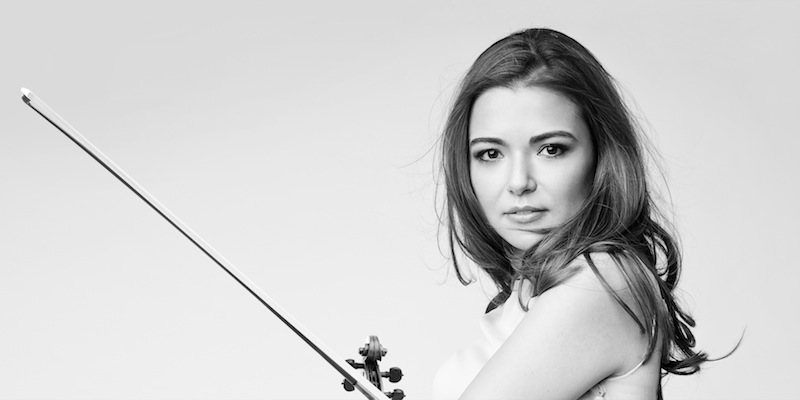
Karen Gomyo was born in Tokyo, but grew up in Montréal. That is, up to the point when, at age 10, she moved to New York City, in order to study at the Juilliard School, at the invitation of Dorothy DeLay. Miss DeLay taught, among many others, my friends Arturo Delmoni and David Kim. Indeed, it’s the rare household-name violinist of the last 50 years whom Miss DeLay did not teach.
Miss Gomyo continued her studies at the Indiana University Jacobs School of Music (yay!) and the New England Conservatory. Apart from Miss DeLay, her teachers included Mauricio Fuks, Donald Weilerstein, and cellist Heinrich Schiff.
In addition to the standard concert repertoire, Miss Gomyo has a great affinity for the music of Astor Piazzolla, and has performed with the late Piazzolla’s former colleagues Pablo Ziegler (whose solo recording on the Steinway & Sons label can be heard here), Hector del Curto (bandoneon), Claudio Ragazzi (electric guitar), and Pedro Giraudo (double bass).
Miss Gomyo has followed up her recording of the Bo Linde violin concerto with an SACD of music for the wonderful combination of violin and classical guitar, which I reviewed last post. Questions and answers after the jump. Continue Reading →
Karen Gomyo and Ismo Eskelinen: Carnival (music for violin and guitar) (SACD)
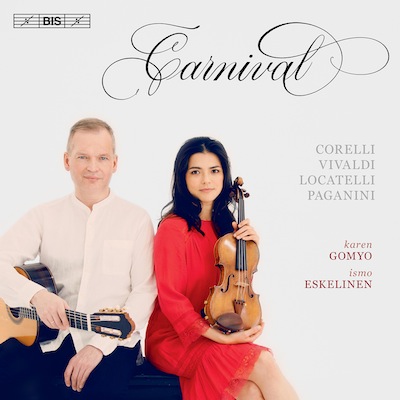
Karen Gomyo and Ismo Eskelinen: Carnival
Music for violin and guitar of Corelli, Vivaldi, Locatelli, and Paganini.
SACD (BIS 1998) and MP3 downloads available from Amazon
Hi-Res downloads (24-bit/96kHz stereo AIFF, ALAC, FLAC, and WAV) available from e-classical and HDTracks
Streaming available from Tidal (and others)
Release date: November 1, 2019
Recorded September 2015 at Troy Savings Bank Music Hall, New York. Producer and recording engineer: Hans Kipfer (Take5 Music Production). Violin by Antonio Stradivari, the ‘Aurora’ (1703); bow by François Tourte (c. 1810); Guitar by Gabriele Lodi (2011). Total time 67 min. 30 sec.
It used to be that only hard-core violin nerds were aware that legendary violinist Niccolò Paganini (1782-1840) played the classical guitar, or that he also composed a substantial body of works for that instrument. Superb recordings such as this one can only increase recognition of that intriguing fact.
This recording places works by Paganini (and a selection of his “Carnival of Venice” variations, with the addition of a new variation by Miss Gomyo) in the context of earlier works by Paganini’s violinist/composer predecessors Corelli, Vivaldi, and Locatelli, who were born in 1653, 1678, and 1695, respectively.
For the earlier Baroque sonatas, the guitarist on this recording, Ismo Eskelinen, created guitar parts from the original basso-continuo parts. But even in the Baroque era, the guitar’s predecessor the lute was a continuo instrument as well as a solo instrument (and also the instrument in the duo genre known as the “lute song”).
For those of us who remember the dawn of the CD medium (I was the founding classical-music columnist of Digital Audio magazine, which was later rebranded as CD Review), mention of the recording venue for this recording should bring a flood of warm memories. The venue for this project was Troy, New York’s Troy Savings Bank Music Hall, which was for many years where Dorian Recordings did most of their work. More information, and sound bytes, after the jump. Continue Reading →
Jakub Józef Orliński: “Vedro con mio diletto” from Il Giustino (Antonio Vivaldi)
There are times when I think that a music-business story is “too good to fact-check,” and this is one of them. Young counter-tenor Jakub Józef Orliński agreed to substitute for an ensemble that could not appear for what Orliński believed would be the radio-only live broadcast of an outdoor afternoon concert in the south of France. The New Yorker picks up the story (after mentioning that Orliński was, on the day of the concert, nursing a mild hangover):
Orliński put on baggy shorts and beat-up sneakers, and rolled up the sleeves of a crumpled tattersall shirt: this was radio, after all, and it was ninety degrees outside. Only when he and his pianist, Alphonse Cémin, who was in shorts and flip-flops, arrived at the recording venue—a courtyard with a small audience—did they learn that the performance was also to be streamed on Facebook Live. It was too late for Orliński to change clothes, and so he sang just as he was—unshaved, and dressed as if ready for a day of sleeping it off under the Provençal plane trees.
This is obviously a superb job of singing; the YouTube view count of 4.7 million views is something I find very heartening. That’s in part because counter-tenors are in a way like harpsichords. In both cases, at times there seems to be a parity between the numbers of people who can enjoy the sound, and those who feel compelled to flee from it. And in that regard, I would have preferred a Baroque continuo rather than a Steinway grand (Vivaldi’s opera dates from 1724), but the piano accompaniment is very sensitive. And one must keep in mind that Orliński was substituting on less than 24 hours’ notice. (I do crack up every time I see the “page turner” reach up and touch the iPad.) Also, for an outdoor concert, what a lovely recording job! More, after the jump.
Continue Reading →
How China Made the Piano Its Own
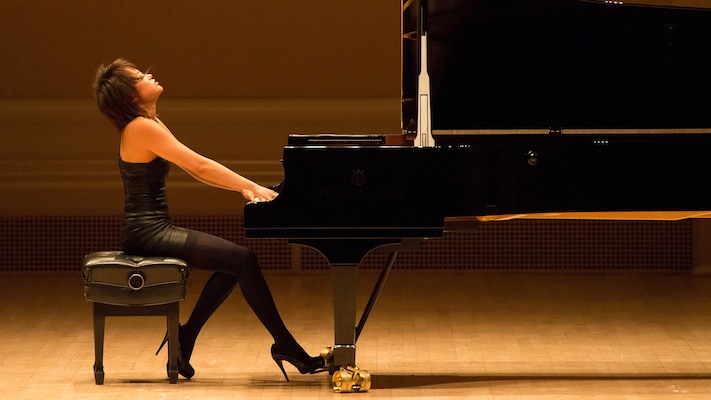 Yuja Wang, courtesy of Medici TV
Yuja Wang, courtesy of Medici TV
This is a first—I can’t ever remember reading an article in The Economist that brought tears to my eyes… . The article in question is, to use academic terminology, a “reception history” of the piano in Chinese culture from the mid-19th century to the present. Here’s the vignette from China’s 1966-1976 “Cultural Revolution” that brought out my handkerchief:
Lu Hong’en, the conductor of the Shanghai Symphony, was thrown into a cell. He continued to hum Beethoven there. After he tore up a copy of Mao’s “Little Red Book,” he was sentenced to death. Lu told a fellow prisoner: “If you get out of here alive, would you do two things? Find my son, and visit Austria, the home of music. Go to Beethoven’s tomb and lay a bouquet of flowers. Tell him that his Chinese disciple was humming the Missa Solemnis as he went to his execution.” Lu was shot within days. His cellmate reached the Viennese grave three decades later.
You will have to read the rest of the article for yourself, here (you probably will have to register to read five free articles a month). I consider this article to be required reading for cultural literacy in classical music in today’s world. The author or authors point out that China is not only turning out star performers (such as Yuja Wang, pictured above); the creation in China of music for the piano has reached critical mass.
The one caveat or clarification I want to offer is that the article states, without elaboration, that the state-run piano company Pearl River (the world’s largest producer) “builds for Steinway.” That statement is, in my opinion, accurate; but also, potentially very misleading. Pearl River does not make Steinway pianos, or even parts or components for Steinway pianos.
What is going on here is that the Steinway company wants its dealers also to be able to offer pianos that are more affordable. Pianos with, if perhaps not Steinway’s imprimatur, at least their nihil obstat. Those brands are the “Boston” and “Essex” pianos. The Essex pianos are “designed by Steinway” and sold by Steinway, but manufactured in China by Pearl River.
The linked-to article also includes an embedded playlist of relevant music and performances, which in and of itself is a reason to click through.
# # #
“The Song of Names” (film)
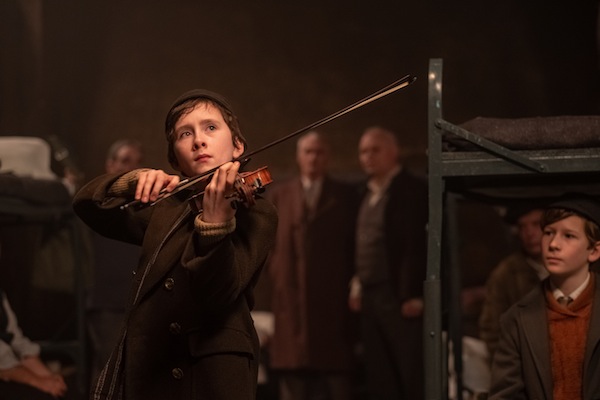
Center: Dovidl (played by Luke Doyle)
© Sabrina Lantos. Courtesy Sony Pictures Classics.
Classical-music fans, especially fans of the violin and its literature, will want to know about the upcoming (opening in selected cities December 25, 2019; nationwide in January) big-screen theatrical release of the film The Song of Names, based on Norman Lebrecht’s prize-winning novel of the same name. The director is François Girard (The Red Violin, Thirty Two Short Films About Glenn Gould); for that reason we can have a high degree of confidence that great care has been taken in getting the musical details right. But all that is not to say that people whose primary musical orientation is other than classical will not also appreciate the film. The plot is compelling, the characters are intriguing, the cinematography is atmospheric, and the film score is by Howard Shore, of Lord of the Rings fame.
Here’s what the film’s US distributor Sony Pictures Classics says about the setup of the film’s action, much of which is told in flashbacks:
Martin Simmonds (Tim Roth) has been haunted throughout his life by the mysterious disappearance of his “brother” and extraordinary best friend, a Polish Jewish virtuoso violinist, Dovidl Rapaport, who vanished shortly before the 1951 London debut concert that would have launched his brilliant career. Thirty-five years later, Martin discovers that Dovidl (Clive Owen) may still be alive, and sets out on an obsessive intercontinental search to find him and learn why he left.
What interests me most, of course, is how successful the production crew has been at allowing the audience to suspend disbelief and accept that the actors on screen are actually playing the violin. Based on what I have seen, I think they have done a very impressive job. Further explanation, the trailer, and a mini-feature on the teenage actor who is also a genuine violin virtuoso, after the jump.
Tenebrae Choir: “Miserere mei, Deus” (Allegri)
Gregorio Allegri’s “Miserere” (Have mercy on me, Lord) is one of the most famous pieces of Late-Renaissance polyphonic a cappella choral music. Either despite or perhaps because of its difficulty, it is also one of the most frequently-recorded pieces of sacred music. The linked-to Wiki gives an excellent overview, so I encourage you to read it. In an interesting historical synchronicity, the most often-cited date for Allegri’s composition of the “Miserere” is 1638, the same year in which Roger Williams (the English lawyer and divine; not the 1950s-1960s lounge pianist) co-founded The First Baptist Church in America. Which was about as distant as one could get (at least within European civilization) from the creation of the “Miserere,” both geographically and culturally.
Another famous synchronicity or at least connection is that while on a tour of Italy, the 14-year old Wolfgang Amadeus Mozart visited the Vatican and heard the “Miserere” on a Wednesday and wrote it down from memory. He returned on Friday to check his work. Given that the “Miserere” had been the “secret piece” of the Sistine Chapel choir, one might have feared for the young Mozart. But, in the event, Pope Clement XIV was a good sport about it, later summoning Mozart to receive the Order of the Golden Spur. It is through the young Mozart’s sharing his work with colleagues that the piece became known throughout Europe; Liszt and Mendelssohn both transcribed it.
There is no shortage of very good performances of this work, and quite a few great performances. I am posting this particular video because it is (by far) the best performance video I have seen; indeed, it is slugged as “A Film by Jon Coates.” The singing is truly extraordinary. However, the pedant within me wishes to point out that in view of what I call “Musical Pitch Inflation” over the past 400 years, I think the consensus of scholars today is that the actual pitch that the solo singer in Mozart’s time sang at the climaxes would, on a modern piano, be a High B, not a High C. And I for one would have no problem with an historically pitch-correct performance.
# # #


